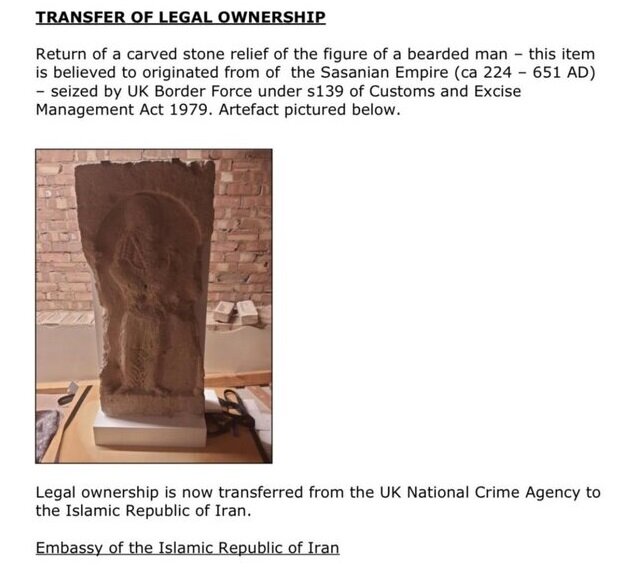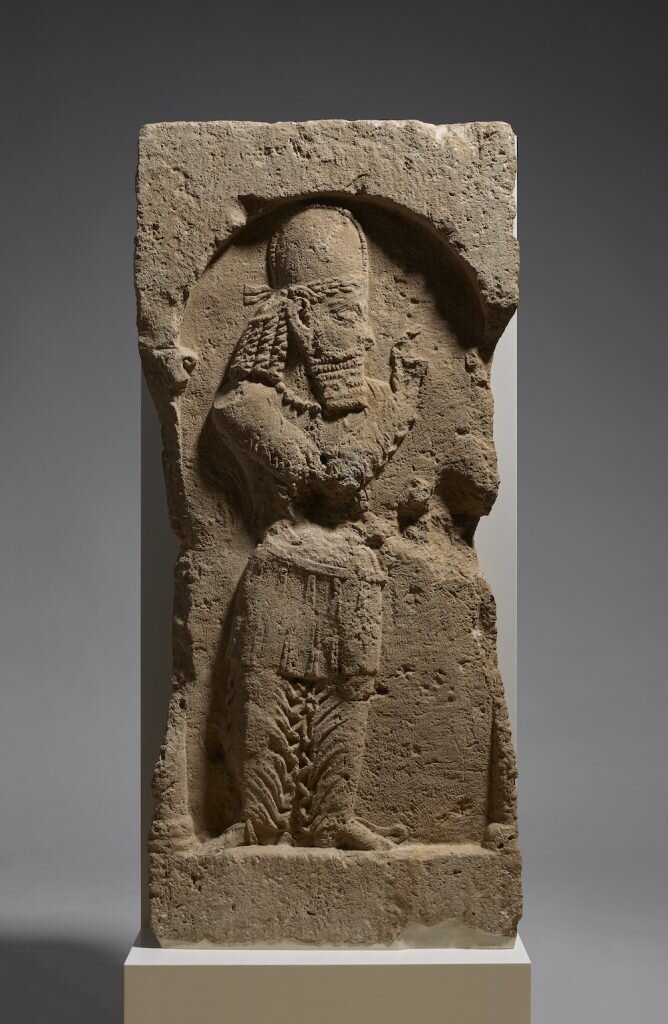UK returns smuggled ancient artifact to Iran

TEHRAN – The Iranian embassy in London has received a smuggled relief of a bearded man believed to originate from the Sassanian Empire (ca 224 – 651 CE).
In a message on his Twitter account on Friday, Seyed Mahdi Hosseini Matin, the chargé d'affaires of Iran to the UK, said the ancient relief has been delivered to Iran embassy in London and will be returned to Iran soon, IRNA reported.
The legal ownership of this precious ancient work is now transferred [from the UK National Crime Agency] to the Islamic Republic of Iran, the envoy said.
This smuggled statue of a Sassanid soldier is handed over to the embassy after proving that it belongs to Iran, and after it was displayed on loan at the British Museum for three months, Hosseini Matin explained.
In a statement issued last month, Hosseini Matin welcomed wider cooperation between the embassy and the British Museum in the arena of protecting cultural heritage. “We sincerely hope that further expansion of cooperation between the British Museum and the Iranian Embassy in London would continue to be effective in fighting against illicit trafficking of cultural properties and protect the cultural heritage of mankind.”
Moreover, Cultural Heritage, Tourism, and Handicrafts Minister Ezzatollah Zarghami said last month that his ministry had put in a great deal of effort to recover the bas-relief carving of Sassanid soldier previously seized at Stansted airport. “Like similar cases, this ministry has devoted all its efforts to return this treasured artifact to the country,” the minister said.
Experts believe the over-one-meter-tall antique was hacked out of live rock or on-site carved rock. It depicts an imposing male figure carved in the 3rd century CE and is estimated to be worth £30 million.
The delicately carved relic was heading for the black market in Britain when it was seized by security personnel. The haphazard packaging, which may have been meant to imply that it was a useless item, made Border Force officers suspicious. The over-one-meter-tall antique was hacked out of live rock or on-site carved rock.

Dr. St John Simpson, a senior curator and archaeologist in the British Museum’s Department of the Middle East, said: “We almost never come across a case of something being cut out of the “living rock.” That’s a level of brutalism that surpasses anything.
“You’ve even got felt-tip marks on the back before they’ve used an angle grinder to slice diagonally behind it and across the top. It was then packed in an incredibly bad manner, in a small, almost unpadded crate held together with nails.
“It belongs to a period when Iran was the center of a powerful empire stretching from Syria to the Caucasus and Central Asia, and with its capital at Ctesiphon, south of present-day Baghdad,” he said. “The Sasanians were powerful rivals of Rome and famous today for their fine silverware and cut glass.”
It is impossible to pinpoint the precise location because the bas-relief has been carved from calcareous limestone, which is found all over Iran. Only a small number —about 30, mostly from the third century— of Sasanian rock reliefs are known to exist. Nearly all of them are in the province of Fars, which is a relatively small area of Iran and is where they originally came from.
Simpson said: “We suspect it comes from somewhere in the Shiraz area. Stylistically, it is similar to one known in the region. I think it probably is part of a big sequence. There might be more bits out there.
“The lack of an inscription makes it impossible to identify the person depicted, but his dress and diademed headdress signify him as a person of high rank. His gesture of greeting and submission, with a raised, bent forefinger, is a feature of Sasanian art when figures are in the presence of royalty, which suggests that this was part of a larger composition, with the king to the right and perhaps other figures behind.”
Due to the poor packing, the relief had split in half. Conservationists have now repaired it for the British Museum.
“It looks amazing,” Simpson said. “It is stunningly attractive. The valuation could be anything, really. We’re talking from £20m to £30m-plus. There’s never been anything like it on the market.”
He said the artifact would be “incredibly valuable” on the black market.
Iran's history places a great deal of significance on the Sassanid era, which saw a general renaissance in Persian art and architecture. The palaces at Ctesiphon, Firuzabad, and Sarvestan, which are among the ensemble's highlights, are examples of grandiose architecture that frequently adopted oversized proportions.
While the Sassanid state promoted scholarship, highly sophisticated crafts like metalwork and gem engraving developed. Works from the East and the West were translated into Pahlavi, the Sassanian language, during those years. The best examples of Sassanian art can be found in southern Iran at Bishapur, Naqsh-e Rostam, and Naqsh-e Rajab. They are rock-carved sculptures and bas-reliefs on abrupt limestone cliffs.
In 2018, a collection of Sassanian historical cities in southern Iran, known as the “Sassanid Archaeological Landscape of Fars Region,” was inscribed on the UNESCO World Heritage list.
AFM
Leave a Comment